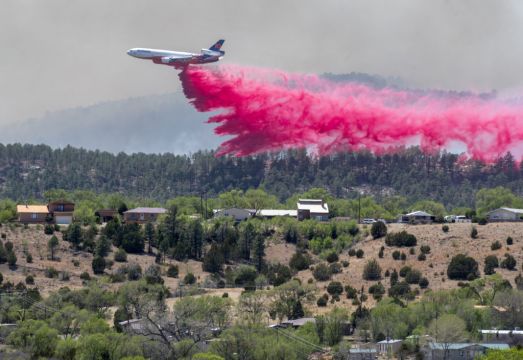Strong winds are expected to blow a worsening wildfire towards a mountain town in New Mexico.
The blaze grew overnight to 250 square miles and is heading towards Las Vegas, which has a population of around 13,000.
Hundreds of square miles have been scorched, with around 170 homes destroyed and more threatened if, as predicted, the flames are whipped through the foothills of the Rocky Mountains.
It comes as New Mexico’s governor asked President Joe Biden to declare a disaster so federal aid can come for the largest fire burning in the US.

Mayor Louie Trujillo said heavy smoke and noise from aircraft tackling the blaze were horrifying at times – but sought to reassure residents that crews are working tirelessly.
“If that fire jumps the ridge, we will be able to defend our city so let the citizens know that we’re not just sitting back waiting for something to happen,” Mr Trujillo said late on Tuesday.
As the fire burned through dry mountainsides on Tuesday, New Mexico governor Michelle Lujan Grisham signed the request for the presidential disaster declaration and said she hopes it will bring financial help for recovery efforts.
She called it important to seek the declaration now, rather than waiting until the fire is out.
Lujan Grisham, a first-term Democrat who is running for re-election, said about 15,500 homes were under evacuation and that the number of homes destroyed would likely rise when it is safe enough for officials to evaluate the damage.
“I have families who don’t know what the next day looks like,” Ms Grisham said.

“I have families who are trying to navigate their children and health care resources, figure out their livelihoods and they’re in every single little community and it must feel to them like they are out there on their own.”
San Miguel County Sheriff Chris Lopez said he has fielded calls from people worried about safety if the fire crests the ridge just west of Las Vegas.
Schools in the community cancelled classes until at least Thursday.
“I can tell you, from my training and experience, (the) town is very defendable,” Mr Lopez said.
“As you go further into town, it becomes a lot more defensible and, you know, we’re doing everything we can to prepare for that.”
Fire engines and crews were stationed on the edge of town and bulldozers cleared more fire lines on the outskirts.
On Wednesday, air tankers and helicopters took advantage of a break in the thick smoke and falling ash to drop fire retardant and water.
Authorities said flames were about two miles from Las Vegas, which is also home to the United World College and New Mexico Highlands University.

New Mexico has been swept by waves of hot, dry and windy weather across the south west.
Forecasters have also issued warnings for parts of Arizona and Colorado, and authorities in Texas urged people there to be careful after several fires started on Monday.
Wildfires have become a year-round threat in the drought-stricken west — moving faster and burning hotter than ever due to climate change, scientists and fire experts say.
Fire officials also point to overgrown and unhealthy forested areas where built-up vegetation can worsen wildfire conditions.
Nationally, the National Interagency Fire Center reported on Wednesday that a dozen unconfined large fires have burned about 436 square miles in five states, including New Mexico.
More than 3,500 firefighters and support personnel are assigned to fires burning across the country.

On the northern flank of the big New Mexico fire, crews were trying to keep the flames from reaching the towns of Cleveland and Mora as winds shifted, said Todd Abel, a fire operations section chief.
Fire lines were holding but state officials urged residents who have refused to leave evacuation areas to reconsider, calling conditions dangerous.
The fire merged last week with another blaze sparked in early April when a prescribed fire set by land managers escaped containment.
The cause of the other fire remains under investigation.
Another New Mexico wildfire burning through forested areas near Los Alamos National Laboratory has charred more than 42 square miles, destroying at least three homes and forcing evacuations.







